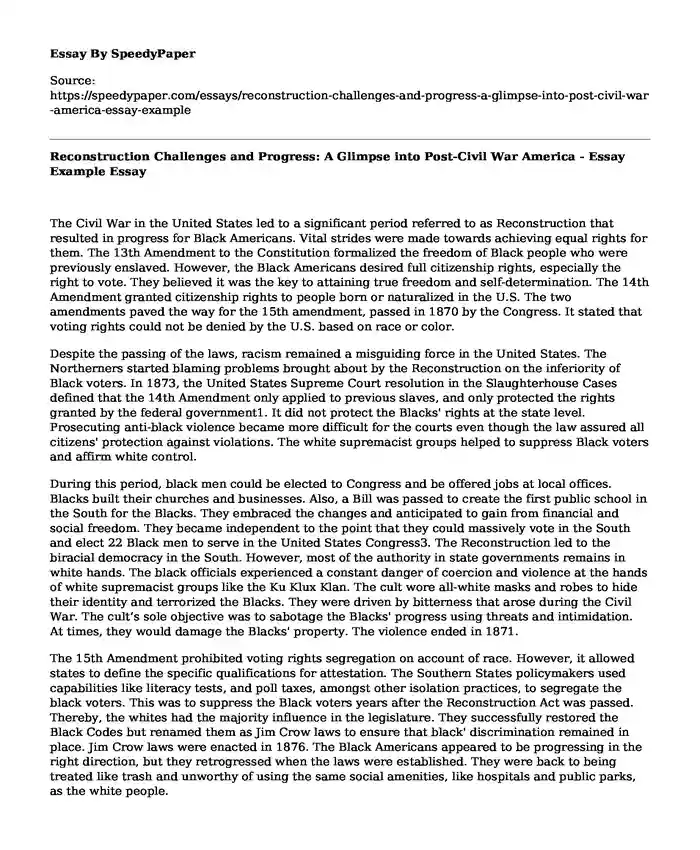
| Type of paper: | Essay |
| Categories: | United States American Civil War Law American history |
| Pages: | 3 |
| Wordcount: | 660 words |
The Civil War in the United States led to a significant period referred to as Reconstruction that resulted in progress for Black Americans. Vital strides were made towards achieving equal rights for them. The 13th Amendment to the Constitution formalized the freedom of Black people who were previously enslaved. However, the Black Americans desired full citizenship rights, especially the right to vote. They believed it was the key to attaining true freedom and self-determination. The 14th Amendment granted citizenship rights to people born or naturalized in the U.S. The two amendments paved the way for the 15th amendment, passed in 1870 by the Congress. It stated that voting rights could not be denied by the U.S. based on race or color.
Despite the passing of the laws, racism remained a misguiding force in the United States. The Northerners started blaming problems brought about by the Reconstruction on the inferiority of Black voters. In 1873, the United States Supreme Court resolution in the Slaughterhouse Cases defined that the 14th Amendment only applied to previous slaves, and only protected the rights granted by the federal government1. It did not protect the Blacks' rights at the state level. Prosecuting anti-black violence became more difficult for the courts even though the law assured all citizens' protection against violations. The white supremacist groups helped to suppress Black voters and affirm white control.
During this period, black men could be elected to Congress and be offered jobs at local offices. Blacks built their churches and businesses. Also, a Bill was passed to create the first public school in the South for the Blacks. They embraced the changes and anticipated to gain from financial and social freedom. They became independent to the point that they could massively vote in the South and elect 22 Black men to serve in the United States Congress3. The Reconstruction led to the biracial democracy in the South. However, most of the authority in state governments remains in white hands. The black officials experienced a constant danger of coercion and violence at the hands of white supremacist groups like the Ku Klux Klan. The cult wore all-white masks and robes to hide their identity and terrorized the Blacks. They were driven by bitterness that arose during the Civil War. The cult’s sole objective was to sabotage the Blacks' progress using threats and intimidation. At times, they would damage the Blacks' property. The violence ended in 1871.
The 15th Amendment prohibited voting rights segregation on account of race. However, it allowed states to define the specific qualifications for attestation. The Southern States policymakers used capabilities like literacy tests, and poll taxes, amongst other isolation practices, to segregate the black voters. This was to suppress the Black voters years after the Reconstruction Act was passed. Thereby, the whites had the majority influence in the legislature. They successfully restored the Black Codes but renamed them as Jim Crow laws to ensure that black' discrimination remained in place. Jim Crow laws were enacted in 1876. The Black Americans appeared to be progressing in the right direction, but they retrogressed when the laws were established. They were back to being treated like trash and unworthy of using the same social amenities, like hospitals and public parks, as the white people.
The Blacks migrated from the South to Kansas in large numbers in 1879. They were running away from the harsh segregation laws. It is crucial to note the 15th Amendment did not apply to black women. The Spelman College and Tuskegee Normal and Industrial Institute were established in the 1880s. These two schools offered the Blacks an opportunity to advance their education and widen their knowledge, resulting in the reforms that occurred in the 20th century.
Bibliography
“THE AMERICAN YAWP READER.” Accessed September 8, 2020. http://www.americanyawp.com/reader/16-capital-and-labor/.
“THE AMERICAN YAWP READER.” Accessed September 8, 2020. http://www.americanyawp.com/reader/reconstruction/.
“THE AMERICAN YAWP READER.” Accessed September 8, 2020. http://www.americanyawp.com/reader/the-civil-war/.
Cite this page
Reconstruction Challenges and Progress: A Glimpse into Post-Civil War America - Essay Example. (2023, Dec 04). Retrieved from https://speedypaper.com/essays/reconstruction-challenges-and-progress-a-glimpse-into-post-civil-war-america-essay-example
Request Removal
If you are the original author of this essay and no longer wish to have it published on the SpeedyPaper website, please click below to request its removal:
- Latino Participation in the World War II, Essay Example for Everyone
- Free Essay. Modern Challenges That We Face
- The Child Witness
- John D.R. Leonard v. PepsiCo, Inc. - Essay Example
- Free Paper Sample: Differences Between Compensatory, Punitive, and Nominal Damages
- Cold War Impact on U.S.: Culture, Politics, Society - Free Paper Sample
- Coronavirus Survey in Minnesota - Essay Sample
Popular categories




